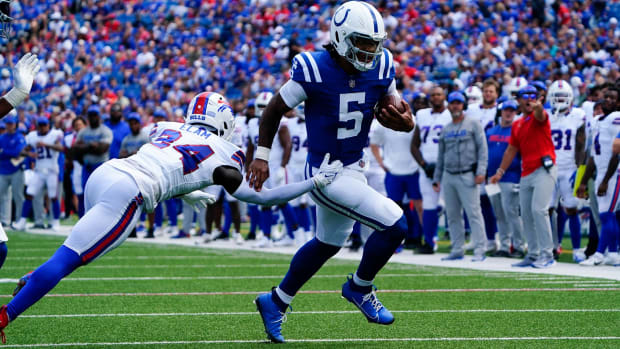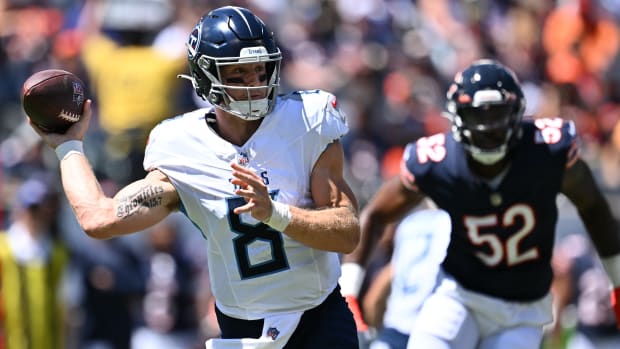
Gregory Fisher/USA TODAY Sports
Like CJ Stroud’s first series with the Texans, Anthony Richardson’s first series with the Colts ended in an interception.
For Stroud, it was a classic case of waiting just a hair too long even if the decision was correct. For Richardson, it was the classic case of a completely broken play resulting in a moment of chaos that produced a less-than-ideal conclusion. From the outset, the final play of Richardson’s first drive seemed doomed. The running back acted as if there was supposed to be play action. There was an (almost) free rusher screaming off his play side. And so, the rookie No. 4 overall pick panicked a bit and threw toward the sideline for a receiver who had stopped the route altogether.
Both of these quarterbacks needed more repetitions and, indeed, Richardson ended up with a handful more drives than the No. 2 overall pick in his preseason debut, lasting almost the entirety of the first quarter. But it was hard not to leave the Colts game just a little bit more excited about Richardson, just not for the reasons one might think.
Richardson looks like Derrick Henry with an arm and the times that he left the pocket on designed runs there was an incredible velocity and violence to it. The undeniable good about his debut was that he didn’t lean on that obvious advantage. By my count, there was only one non-designed run in which Richardson left the pocket, and that play ended up being called back anyway. He finished the game 7-of-12 for 67 yards and an interception with a quarterback rating of 39.2.
While watching him I was reminded of last preseason, when Malik Willis was getting his first professional reps with the Titans. His instructions were obvious: we already know you are incredibly talented as a rusher, so don’t show us that in the preseason. Use the reps to round out the other parts of your game.
And while I’m not sure if there was a similar directive for Richardson, his complete and total willingness to remain in the pocket and download the additional repetitions as a pure passer was obvious and encouraging. He could have left the pocket on each and every drive, flattening the Bills’ secondary like a padded Tyrannosaurus. Instead, he made quick, decisive throws. His motion looked similar on each pass and he lofted a beautiful pass on a corner route to Alec Pierce that should have been caught and should have set the Colts up for an easy touchdown.
Unlike Stroud’s debut, there was only a brief window of that very real intimidation that comes with a transfer from practice speed to game speed at the NFL level. Stroud felt like he had problems trusting himself, whereas Richardson kept his finger on the trigger, willing to accept the good with the bad.
While we’re trying to be measured and not derive some grand conclusions about a quarter of practice football, this was the kind of start the Colts could easily build on. Coming out of college, Richardson had a low completion percentage (the source of which is up for debate) and very few starts. The distance between there and here has been significant and allows us to buy into the high-ceiling gamble made by the Colts.

Jim Dedmon/USA TODAY Sports
Bryce Young flashed a little smile and looked at the scoreboard before his first possession as the Carolina Panthers quarterback. Not always the most demonstrative player, this is about as much emotion as he showed during his first snaps in the NFL.
On Young’s first series, it was notable that he took a few big hits, including one from veteran Solomon Thomas who, intentionally or not, followed the initial hit with a bit of a forearm club to the face mask while Young was getting up. Young also completed a pass to Adam Thielen while getting hit and attempted a third-down conversion pass to DJ Chark Jr. while also taking contact. Each time, he quickly bounced back up.
Young’s slender frame and the attention around his ability to get near 200 pounds before the start of the scouting combine was dependable pre-draft kindling. However, I had one trusted evaluator tell me that Young has done well to evolve himself as a taker of contact. As opposed to a smaller-framed quarterback like Tua Tagovailoa, Young’s body tends to travel with momentum instead of against it. Does it still hurt? Sure. Does it create as much lasting damage? The hope is no.
Young took snaps both from the shotgun and under center. A few of his very early throws had some RPO action attached to it, though we saw some traditional looks as well, which jibes from the division of collegiate and professional-style offenses Young operated under with Bill O’Brien at Alabama.
Young’s second drive started backed up on his own 1-yard line, which Frank Reich let him pass out of on two of three downs. Young was quick and decisive, dumping the ball off for running back Chuba Hubbard for a three-yard completion. A third down conversion attempt to Laviska Shenault Jr., which was a similar single coverage 50-50 attempt to the ball he threw to Chark on the first series, fell incomplete.
The bad field position likely triggered the third series for Young, which made him the third of four highly-drafted quarterbacks to take reps beyond the first quarter. Young’s final drive ended with a complete breakdown of the offensive line on a third-and-4, where, at the very least, we again saw Young’s ability to handle the violence of the game. He folded in on himself completely before getting mobbed by a handful of defenders.

Jamie Sabau/USA TODAY Sports
Unlike Richardson and Young, Will Levis isn’t expected to carry the burden of starter’s snaps this year, so we’ll keep his breakdown brief. Levis is actively competing for the No. 2 job with Willis, who started Saturday’s game against the Bears and alternated drives with the hulking quarterback from Kentucky. Levis played in parts of all four quarters, finishing his day with 9 completions on 14 attempts for 85 yards and an interception.
Levis’s debut was not short of welcome rookie moments. He threw a dangerous ball that was almost picked off by Tyrique Stevenson. Had Stevenson kept his hands on the ball, there’s a good chance he would have returned it for a touchdown.
Levis was also buried from his blind side by Zacch Pickens, who emerged from a sloppily executed stunt and planted Levis into the ground. The instant analysis is difficult because of the lack of All-22 film which shows the entirety of the field, but Levis seemed to think he had more time to cycle through his progressions. That was a similar posture for some of the sacks he sustained in the second half, where it looked as though he needed more time (or wanted more time) to transfer from one receiver to the next.
Still, Levis was closer to Richardson in that the innate good from his collegiate film was still on display. He threw well on the move, including a 21-yard pass while rolling to his right side to Mason Kinsey. The throw was dropped in the middle of a triangle of defenders. The low and away positioning of the pass, which, to me, looked intentional, was the first really good example of any of the rookie passers strategically throwing their receivers open. Kinsey was being trailed from the middle of the field, and the ball was lower and toward the sideline.
Later in that same quarter, Levis was able to use pump action to get himself some room for a completion to Racey McMath (captured here by the great Justin Graver). The third-and-13 situation made the veteran move all the more impressive. He attacked a similar second-and-forever situation with the same poise in the second half, making good economical throws and decisions.
Levis threw an interception, though it came with 10 seconds remaining on the clock and the Titans trailing by a score, which is a situation where you’d rather see him be aggressive and try to force throws than to be conservative.
Unlike Richardson, I was hoping to see more designed runs for Levis, but perhaps he is on a similar Willis-like preseason prescription. His only first-half run was an escape from the pocket where he looked strategically mobile, but not as much the Josh Allen-like thudder I thought.







